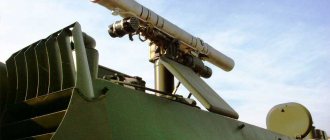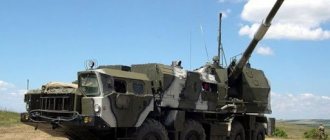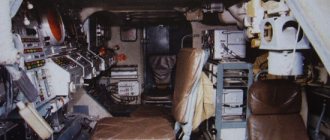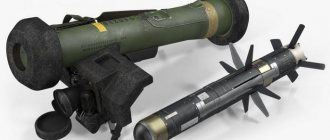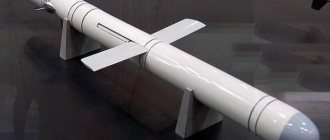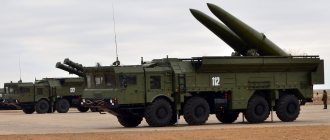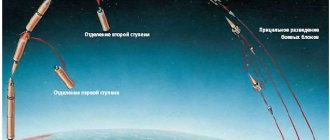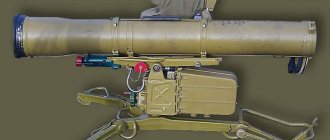Purpose, composition, performance characteristics of the R-330B.
ASP R-330B is designed for detection, direction finding, technical analysis of radio emissions and radio suppression by targeted interference of radio communication lines at the enemy’s tactical command and control level in the frequency range 30-100 MHz.
TSA provides:
— automatic search and detection of radio emission sources (ERS) within the frequency range (or in a given section of the range);
— automatic direction finding of detected radioactive sources;
— displaying the frequency and bearing values of detected irradiation sources on the UUS display (station control device);
— determination of whether detected irradiation sources belong to an electronic jamming (electronic jamming) object by the operator’s analysis of frequency values, signal parameters and bearings;
— recording and storing in a memory (storage device) the values of the boundaries of a given detection sector (direction finding);
- recording and storage in memory:
- frequency values at which interference is prohibited (DZU);
- frequency values not intended for analysis (RAM);
- frequency values to be suppressed (ROM) - without interference signal parameters;
- values of frequencies to be suppressed (ROM - 200) - up to 240 frequencies with parameters of the interference signal;
- recording and storage in the ZUPCH (ZUPCH-T) of ten suppressed frequencies with parameters (frequency rating, type of transmission, parameters of the interference signal, bearing, priority) in each, with their display on the indicators of the BZUPCH block (storage device for suppressed frequencies);
— interference emission in the azimuthal sector 1100 ± 100, in continuous or sampled modes. In this case, frequencies are selected randomly from the number (maximum 10) designated for suppression (taking into account their priority) when they appear on the air. The station provides quasi-simultaneous suppression of up to 4 radio communication lines, which is optimal when controlled from the R-330K control unit. The fewer frequencies given to suppression, the greater the efficiency;
— automatic exclusion from the analysis of irradiance frequencies, the values of which are recorded in the remote memory, RAM, as well as irradiance frequencies located outside a given reconnaissance sector;
— automatic monitoring of the state of suppressed radio communication lines (WORKING - NOT WORKING);
— autonomous or manual control of the station;
— centralized control of the station with the R-330K control unit.
Electronic warfare station R-934U “Sinitsa”. When "Tit" is in the field, it's hard for the cranes in the sky
Another representative of the electronic warfare equipment, a very distinguished one, is the R-934U or “Sinitsa” automatic jamming station.
The station was originally developed to detect, determine direction, coordinates and electronic jamming of aviation VHF radio communications and tactical aviation guidance systems.
In the process of improvement and modernization, the ability to work via terrestrial radio communication points, both fixed and mobile, was added.
The calculation of the station will not be confused by the presence of enemy radio stations with the function of programmable frequency tuning (PRFC) and the ability to transmit digital short messages in telecode mode. The "Tit" will suppress everything it can reach.
Tested by its predecessors R-934B during both Chechen campaigns.
But the main purpose of the R-934U is to interfere with aviation. Noise, pulse, targeted and misleading interference, modulated both in signal amplitude and frequency.
If translated into normal language, the main task is to disrupt the targeting of enemy strike or fighter aircraft, disrupt coordination between aircraft, and also block the transmission of data from a reconnaissance aircraft.
"Tit" can also be used to communicate with its aircraft or ground points.
The R-934U can operate in autonomous mode, in pairing mode with another station, or under the overall control of a single command post of the Diabazol complex.
In autonomous operating mode, the station detects sources of radio emissions in a given frequency range, takes bearings and automatically analyzes them. A list of explored frequencies is generated, from which the operator, at the direction of the station commander, creates lists of prohibited frequencies and those intended for suppression.
Signals of controlled fixed frequencies, when appearing on the air, are heard on the station's loudspeaker. If necessary, speech information can be recorded on a built-in electronic tape recorder. Signals for listening and recording are selected both manually and automatically. After analyzing the information, a list of priority frequencies intended for suppression is generated. When the station commander receives permission (command), the station is switched on to the suppression mode for radio emission sources from this list.
The autonomous mode is characterized by increased efficiency, since a single station is used, which can be quickly deployed and begin combat work. There is no need to determine your own coordinates, the procedure for entering into communication and synchronization with associated stations.
In the coupled pair mode, two stations operate, separated along the front by up to 10 km. In this case, they exchange information with each other via a radio relay channel. Based on bearings determined by calculations, the coordinates of the suppression object are determined. When working with a control point, all received information (except for voice) is sent to it for analysis, after which targets are distributed between stations.
Technical characteristics: Frequency range, MHz: - receiver: 100-400 - transmitter: 100-150, 150-220, 220-400 Transmitter frequency grid step, kHz: 1.0 Output power of the transmitting device, W: not less than 500 Determination accuracy carrier, kHz no more than ± 4 Sensitivity of the receiving device, μV no worse than 1.5 Frequency range scanning speed (without direction finding), GHz/s no less than 26 Viewing/suppression angle: 360 degrees Range: up to 250 km.
The station allows continuous operation for 24 hours with a ratio of operating time for reception and transmission of 3:1.
The time to deploy and bring the station into combat position is no more than 30 minutes. An experimental calculation takes less time.
The crew proudly demonstrated the engine of their Ural after another repair. The envy of lovers of powerful American-style V-shapes.
There is not enough space inside the kung. There is a place for the operator, and, perhaps, that's all. The rest is filled with cabinets with equipment.
And two tables as a workstation for the station operator.
The first one has a standard set: a system unit and a printer. The printer surprised me. But the thing is apparently necessary, since it records all the victories (or failures) of the operator and dumps them on paper on the command desk.
Well, the operator himself is fully armed.
Yes, the kit also includes a GLONASS navigator. But since the “Tit” stood about 100 meters from the “Zhitel”, the navigator showed zeros. Like all similar devices in the area.
But the proximity to the “Resident” did not affect the operation of the rest of the equipment.
Everything functioned as expected and the task was completed.
What else can be said about “Sinitsa”?
The station crew with whom I spoke had a very, very high opinion of their combat vehicle. Looking towards the “Krasukha”, around which the rest of the correspondents were crowding, the fighters, without belittling its capabilities, openly praised their “Tit”.
The arguments were very reasonable. Minimum mechanization during deployment. If there is nothing to break or jam, then nothing will break. Especially in disgusting field conditions in the form of snow, rain, or, for example, wind and sand.
"Krasukha" is a rapier. Very small angle of working grip and suppression. “Tit” is a club that can stun a range of 360 degrees and to the full depth. Together. Moreover, the operating range of the “Sinitsa” is no less.
Of course, every normal sandpiper praises his swamp. One can argue for a long time what is better, turning off the aircraft's radar or completely depriving it of communication with the guidance point, reconnaissance aircraft, aircraft of its group and dispatchers.
As a matter of fact, it’s better to have both at once. And even without bread. I mean, you don’t have to plow up the “Resident” so that at least the pilots can report on their cell phones about the cataclysm that has befallen them. Before a completely reasonable ejection or forced landing.
In general, the guys were looking forward to the business trip for the R-330BMW. Expecting new experiences and new opportunities from the new station. It is quite possible that in the near future we will get to know the new ASP entering service with the radio-electronic troops.
Composition of TSA
1) operator station equipment (GA-100M):
- station control device UUS-3;
- search and direction finding device (R-381T2-1);
- R-399T analyzer;
2) remote control equipment (GA-110):
- UITS;
- radio relay station R-415V;
- AI-011 data transmission equipment;
- wire line switching unit BC PLS (GA-733);
3) interference transmitter:
- interference transmitter power amplifier (GA-210);
- ChZT equipment (GA-220M);
- antenna-feeder equipment (GA-230);
4) communication equipment:
- VHF r/station R –173;
- internal communication and switching equipment P-174;
5) power supply system equipment:
- electric unit AD16U – T/400 – 1VP;
- distribution devices GA – 501, GA – 502;
- GA input panel – 503;
- Secondary power supplies +27V (AN-482); +9V (GA -702);
- Voltage stabilizer STS16/ 0.5C – 380/380;
- External shield AB – 168.
6) auxiliary equipment:
- OV heater – 65G;
- air conditioner 1K21-3;
- filter and ventilation unit FVU – 200;
- telescopic mast.
The placement of equipment in MT-Lbu is shown in Fig. 1.1.
The diagram of functional connections between the systems and devices of the station is shown in Fig. 1.2.
R-330
R-330 "Mandate" - Soviet electronic warfare system. It consisted of a R-330K control center and automated radio jamming stations. The electronic warfare stations included the R-330B “Mandat-B”, R-330U “Ukol”, R-330P “Pyramid”, as well as the R-325U, R-378A(B) stations. The Tambov Research Institute of Radio Engineering "EFIR" (JSC TNIIR "EFIR"), now part of the Sozvezdie concern,[1] and the Research Institute of Integrated Automation (NIIKA, Donetsk)[2] took part in the development of the complex.
Designed for radio reconnaissance and radio suppression of enemy radio communication lines at tactical and operational-tactical control levels in the range from 1.5 to 100 MHz. Control of jamming stations can be carried out in automated and manual modes. In addition, electronic warfare stations can operate autonomously, without a control center.
The R-330 “Mandate” and individual stations are in service with electronic warfare units and units of the Ground Forces of Russia, Ukraine and Belarus.
Performance characteristics
The PU can be powered either from a transported power station or from an external network with a voltage of 380 V and a frequency of 50 Hz. In addition, emergency power supply is provided - two series-connected 6ST-60 batteries in the control vehicle, as well as a backup - two series-connected 6ST-190 batteries in each vehicle for the body life support system.
The equipment of the complex is located in van bodies and can operate in the ambient temperature range from -10 degrees to + 50 degrees.
The speed of the computing complex is 750,000 operations per second. Memory capacity of the computing complex: resident (internal) - 28 kilobytes; external - 208 kilobytes.
- Remote control range of jamming stations when operating radio relay stations R-415V: on a whip antenna: up to 12 km;
- when working with a directional antenna: up to 30 km.
- control machines and hardware communication machines - 8000x2700x3600 mm;
- control machines - 10700 kg;
R-330B
The station is mounted on the MT-LB chassis.[3] Developed by TNIIR "Efir". Operating frequency range 30..100 MHz. Transmitter power – 1 kW.
R-330U "Injection"
| External images | |
| R-330 "Mandate" | |
Entered service in 1985.[4] The composition of the PU complex “Injection” includes:
- control vehicle on a car chassis (Ural-375);
- trailed power station ESB-12 with a power of 12 kW, based on the GAZ-24 engine
Designed for radio reconnaissance in the range of 30-100 MHz, and suppression in the range of 30-60 MHz. Transmitter power 1 kW. The antennas of the complex are installed on a telescopic mast 12 m high (device weight 90 kg). The antenna complex consists of a radio direction finding antenna (Adcock-Komolov array) and a log-periodic flexible antenna designed for radiation. It includes a radio relay communication station (the height of the mast reaches 18 m) and a R-107M communication station.
Modifications
"Borisoglebsk" and "Borisoglebsk-2" (Russia)
In 1999..2001, the R-330B station was modernized by the developer (TNIIR "Efir", R&D "Borisoglebsk").[5]. Based on the results of the development work, a number of stations were modernized.
In 2004, the Borisoglebsk-2 development and development work began. The main executor of the Borisoglebsk-2 design and development work and the manufacturer of the complex is JSC Concern Sozvezdie. As a result, the complex was completely redesigned and accepted for mass production. In 2013, the first 8 RB-301B Borisoglebsk-2 complexes were put into service. Includes the R-330KMV control center with R-378BMV, R-330BMV, R-934BMV and R-325UMV jamming stations.[6] The concern also offers an export control cabin R-330K[7] and station R-330T[8].
"Mandate-M/B1E" (Ukraine)
The modernization was carried out by the State Joint Stock Holding Company. Several states have become interested in the Mandat-M complex, which consists of 10 vehicles and has the Navstar Glonass GPS system as a topographic reference. The modernized complex can provide reliable suppression of up to two, the most modern radio communication lines (in the HF and VHF bands)[9].
According to the technical specifications, the Vepr-S all-wheel drive armored vehicle was developed for use in the Mandat-B1E electronic defense complex[10].
In June 2013, tests of the Mandat-B1E complex were completed [11]. The adoption of the complex into service by the Ukrainian army is planned for 2013[12].
"Mandat-M" (Belarus)
The Mandat-M complex was created by the research and production republican enterprise KB Radar[13]. Modernization of jamming stations consists of completely replacing all radio-electronic equipment (with the exception of the power amplifier), adding new means of communication, and improving life support conditions. As a result of modernization, the tactical and technical characteristics of the complex have increased and are provided with:
- panoramic detection and direction finding based on digital signal processing;
- collection, processing and storage of information in computer databases;
- display of the radio-electronic situation on a digital map of the area;
- automatic ranking and target distribution;
- detection and radio jamming of communication lines with rapid frequency hopping.
The R-330K control center was modernized by completely replacing all electronic equipment with the exception of communications equipment and installing new software.
Spectrum analyzer R - 399T
Spectrum analyzer R - 399T is intended for:
- determining the structure of radio signal spectra during visual analysis;
- oscillographic observation of signals;
- measuring their main parameters in manual mode, namely:
- for TLF signals - spectrum width;
- for TLG signals – the frequency spacing of CT and DCT transmissions and the duration of elementary bursts, through the values of which the telegraphing speed is calculated.
The measured parameters are used to correctly assign the parameters of the interference signal and are entered by the operator into the control system. The signal to the analyzer is supplied from the soft starter at an intermediate frequency of 500 kHz.
